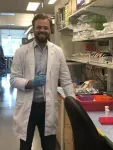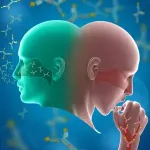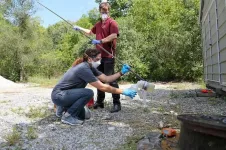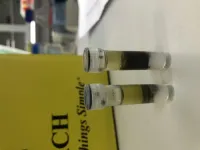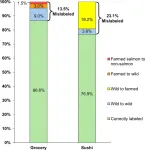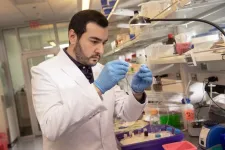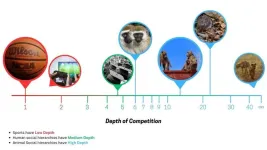(Press-News.org) Safety is not only for truck drivers, but also the drivers around them.
The Virginia Tech Transportation Institute recently received nearly $1 million in two grants from the U.S. Department of Transportation’s Federal Motor Carrier Safety Administration to develop and enhance tractor-trailer educational programs.
“These two grants will allow us to continue transforming our research into practice,” said Rich Hanowski, director of the institute's division of freight, transit, and heavy vehicle safety. “The outreach initiatives will directly leave an impact on drivers and are supporting our efforts to save lives.”
Technology education for truck drivers
Rebecca Hammond and her team were awarded $490,000 to support the development of a series of interdisciplinary training materials to educate truck drivers on advanced driver assistance systems (ADAS).
According to Hammond, systems such as adaptive cruise control, blind spot warning, automatic emergency braking, and more are becoming increasingly popular on cars and trucks and have the potential to mitigate crashes and save lives. However, there has been a lack of education and research around the use of these technologies in tractor-trailers.
“Our goal is to educate both the truck driver and the fleet management on the benefits of these technologies that are making their way into heavy vehicles,” said Hammond, group leader of heavy vehicle programs and initiatives at the institute. “There are some drivers who have been on the road for 30 to 40 years who may be apprehensive to use these technologies. We are hoping to show them ADAS technologies can make their drives safer and easier.”
The two-year project aims to
Develop ADAS training videos for drivers
Create a website to house the videos and other training materials
Create an immersive virtual reality training for drivers who have not experienced ADAS technologies
Implement and disseminate the trainings in-person at various trucking industry events and fleet safety meetings
While minimal research is available, one study conducted by the institute in 2017 noted the potential for technologies such as automatic emergency braking and lane departure warning, among other technologies, could help avoid 500 fatalities annually.
Sharing the Road with Large Trucks program
In a separate grant, $455,000 was awarded to support the nationwide expansion of the institute's safer driving outreach program, Sharing the Road with Large Trucks. The program, which gives participants a first-hand experience of a semi-truck's blind spots from the driver’s perspective, currently operates primarily in the mid-Atlantic region.
“Drivers across the country also are in need of a program like this,” said Matt Camden, group leader of the institute's research to practice and outreach group. “We are excited for the opportunity to expand our program and engage with drivers in new areas and teach them how to safely drive around semi-trucks.”
The grant will allow the team to visit 90 schools in previously unvisited regions over the next two year and to attend additional community events and conferences. The grant also will support translating the program’s educational materials into Spanish, allowing the important safety-related information to reach an audience that may not speak or read English fluently.
Since its 2017 inception, Sharing the Road with Large Trucks has worked with over 45,000 students across 353 school visits and has engaged with over 8,200 community members during 47 public events.
END
Transportation institute awarded nearly $1 million in trucking education grants
2024-11-06
ELSE PRESS RELEASES FROM THIS DATE:
Sewage surveillance proves powerful in combating antimicrobial resistance
2024-11-06
Waterborne diseases affect over 7 million people in the U.S. every year, according to the Centers for Disease Control and Prevention, and cost our health care system over $3 billion. But they don’t impact all people equally.
A campuswide collaboration is using sewage surveillance as a vital strategy in the fight against diseases that spread through the water such as legionella and shigella. The ones that are most difficult to combat are diseases with antimicrobial resistance, which means they are able to survive against antibiotics that are intended to kill them.
A recent paper in Nature Water offers an encouraging insight: Monitoring ...
Natural environment is declining: are companies doing their part to save it?
2024-11-06
The natural environment across the globe is deteriorating, leading to crises like climate change, biodiversity loss, and water scarcity. Companies and industries play a major role in this decline, and they are expected to take responsibility for their environmental impact. A recent study by Probal Dutta from the University of Vaasa, Finland, suggests that companies can meet these expectations by openly sharing reliable, credible information about their activities, environmental performance, and effects on nature.
Probal Dutta’s doctoral dissertation at the University ...
New study sheds light on the role of sound and music in gendered toy marketing
2024-11-06
A groundbreaking study from Queen Mary University of London reveals that the music and soundscapes used in toy commercials are reinforcing rigid gender norms, shaping the way children perceive masculinity and femininity. The research uncovers how gender stereotypes are not only conveyed through visuals and language but are also deeply embedded in the sound and music used in advertisements targeted at children.
For more than 40 years, research has shown how gender polarisation in children’s ...
Pathogens which cling to microplastics may survive wastewater treatment
2024-11-06
Wastewater treatment fails to kill several human pathogens when they hide out on microplastics in the water, reports a new study led by Ingun Lund Witsø of the Norwegian University of Life Sciences, published November 6, 2024 in the open-access journal PLOS ONE.
Wastewater treatment plants are designed to remove contaminants from wastewater, but microplastics persist and can become colonized by a sticky microbial biofilm. Previous research has suggested that these microbial communities, called plastispheres, include potential pathogens, and thus might pose a risk to human health and the environment when treated wastewater and sludge are released.
In the new study, researchers ...
Effects of preterm birth extend into adulthood, study finds
2024-11-06
By analyzing all live births in Canada over a six-year period and following children for more than two decades, researchers found that preterm births and the related cognitive, development and physical health impacts of prematurity are associated with lower income, employment and university enrollment
Individuals born before 37 weeks of gestation, considered to be preterm infants, have, on average, lower employment income, university enrollment and educational attainment through age 28, according to ...
Salmon frequently mislabeled in Seattle grocery stores and sushi restaurants
2024-11-06
In a study of salmon samples from Seattle, Washington, grocery stores and sushi restaurants, DNA analysis revealed that 18 percent were mislabeled. Tracie Delgado and colleagues at Seattle Pacific University, WA, U.S., present these findings in the open-access journal PLOS ONE on November 6, 2024.
Washington State is one of the top suppliers of wild salmon eaten in the United States. The price of salmon depends on the species and whether it is farmed or wild caught. Prior studies have revealed frequent mislabeling of salmon in Washington markets and restaurants. In 2013, the state made it illegal to mislabel salmon, citing negative ...
15,800-year-old engraved plaquettes from modern-day Germany depict fishing techniques, including the use of nets, not previously known in the Upper Paleolithic
2024-11-06
15,800-year-old engraved plaquettes from modern-day Germany depict fishing techniques, including the use of nets, not previously known in the Upper Paleolithic
###
Article URL: https://journals.plos.org/plosone/article?id=10.1371/journal.pone.0311302
Article Title: Upper Palaeolithic fishing techniques: Insights from the engraved plaquettes of the Magdalenian site of Gönnersdorf, Germany
Author Countries: Germany, U.K.
Funding: Deutsche Forschungsgemeinschaft DFG (Germany) - AHRC (UK) Memorandum of Understanding Grant DFG-Projekt GZ: GA 683/13-1 (AOBJ: 647648); AHRC (UK) AH/V002899/1) Kunst und Haushalt im Paläolithikum: ...
How plants evolved multiple ways to override genetic instructions
2024-11-06
Biologists at Washington University in St. Louis have discovered the origin of a curious duplication that gives plants multiple ways to override instructions that are coded into their DNA. This research could help scientists exploit a plant’s existing systems to favor traits that make it more resilient to environmental changes, like heat or drought stress.
The study led by Xuehua Zhong, a professor of biology in Arts & Sciences, was published Nov. 6 in Science Advances.
Zhong’s new research focuses on DNA methylation, a normal biological process in living cells wherein small chemical groups called methyl ...
Nasal swab tests predict COVID-19 disease severity, Emory study finds
2024-11-06
A wide variety of COVID-19 symptoms exist, ranging from mild to severe, and while current strains of the virus generally cause milder symptoms, those with co-morbidities are still at an exponentially greater risk of severe disease. Now, new research from Emory University is providing a more precise prediction of COVID-19 severity that can be found by looking at autoantibodies in the nasal cavity, leading to more personalized treatment plans. For high-risk individuals, this could provide critical information to inform immediate treatment options, including ...
'Shallow' sports and 'deep' social hierarchies: Not all pecking orders are created equal
2024-11-06
University of Michigan researchers have added a new dimension to the mathematics used to predict the outcomes of all manner of competitions, including sports, games and social hierarchies in both humans and animals.
This dimension, which they call "depth of competition," can be integrated into a variety of important and lucrative fields. It could, for instance, help project winners of match-ups in sports, forecast consumer preferences, rank universities and evaluate hiring practices.
But it also ...

